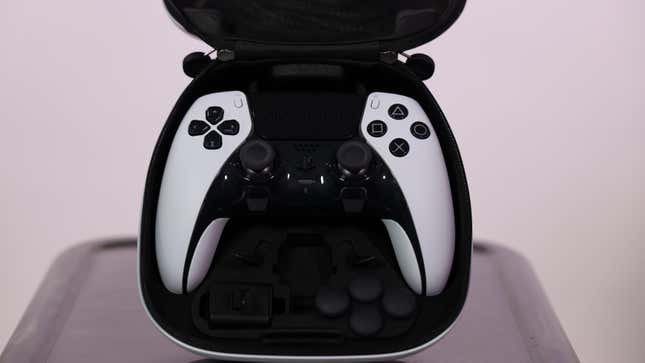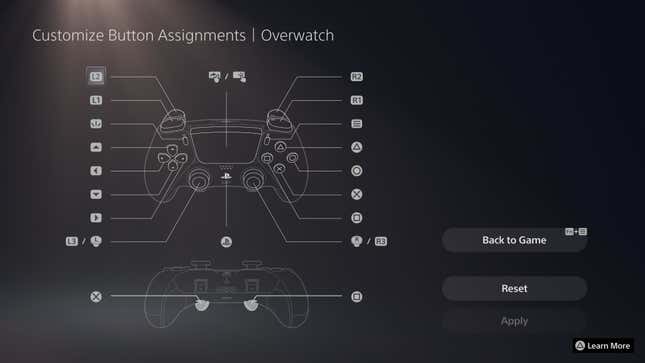
I’ve spent about a dozen hours playing games with the new DualSense Edge. At first, all the modular PlayStation 5 controller’s new bells and whistles feel extremely superfluous to me. I‘ve been playing video games on standard controllers all my life without issue, and even the settings the controller has doesn’t feel like it’s actually addressing issues I have in some games—like a lack of buttons for additional inputs or mapping button combinations for ease of use. But that all changes during a match of Overwatch 2.
I’m in a fire fight, playing as Soldier: 76, and while I’m holding off my opponent’s team well enough, I don’t notice a Pharah has flown around the fight and into our back line. By the time I hear her, she’s already dropping rockets on my team, and as I turn around to face her with the right thumbstick, I also use the back paddle to reload without having to move my thumb to the square button or pull some claw maneuver to do both actions. Because of that split second, I shoot down Pharah before she’s able to do too much damage. That’s when the gears start turning in my head about the perks of the DualSense Edge.
In most action-oriented video games, the shift between winning and losing a fight can happen in split seconds. The more I use the DualSense Edge and fiddle with its different settings, the more I remember moments over the years where, had I been able to change the kind of things these controllers allow I might have emerged victorious, rather than dying in the milliseconds it took me to push a trigger button down and lift my finger to release it. The controller’s adjustable triggers, which allow me to set travel distance between the standard setting and two shorter ones, are great boon for me in shooters like Overwatch, largely because they make the time to shoot just a little bit faster, but those few seconds add up as a match goes on, and a second can be the difference between a shot fired and your own HP reaching zero.

The customization also has benefits for those with chronic pain, as adjustable triggers, analog sticks of different heights, and back paddles of varying length give the DualSense Edge several avenues to adjust a standard controller in a way that makes using it more comfortable. I end up using the shorter back buttons because I have smaller hands, anyway, so it feels like a more natural fit for how I hold a controller, though some folks who have a lighter touch would likely get more benefit out of the longer paddles.
That being said, if you’re a person who has trouble holding a traditional controller, the DualSense Edge will likely not alleviate your issues. However, Sony does have the upcoming controller codenamed ”Project Leonardo” is specifically designed to be as customizable as possible for those who need that for accessibility reasons. The DualSense Edge has a lot of great options for fine-tuning your own controller experience, but it is, at the end of the day, a fairly traditional controller that might not accommodate everyone’s needs.
All of this being said, the DualSense Edge still feels like a luxury item in a lot of ways, and has some notable drawbacks for the $200 price. The one that would likely give folks pause is the battery life, which is noticeably shorter than the original DualSense (not that it had great battery life either, but I digress). However, unlike the standard controller, the DualSense Edge comes with a nearly three-meter-long braided USB cable and a connector to keep it plugged into your PlayStation 5 and charging. It’s not ideal, but if your entertainment center is set up for it, you can at least charge the DualSense Edge while playing fairly easily out of the box.
The DualSense Edge’s biggest disappointment is that despite the additional buttons, the actual customization of control schemes is entirely limited to moving existing buttons to the back of your controller. Oftentimes, when I play a game on my PlayStation that was primarily built for PC, I find myself hurting for buttons. The most recent example was Final Fantasy XIV, which I made the mistake of starting on PS5 rather than PC—navigating through that game on a controller still feels insurmountable to me on a DualSense Edge. I was hoping the additional buttons would give me a means to assign certain shorthand inputs to the other buttons, but all the back paddles really do is act as replacements for buttons that are already elsewhere on the same controller. Now that I’ve had some time with it, I realize this goes beyond the scope of what the DualSense Edge is actually meant to do, but if you’re hoping to use the controller as a way to expand your input options, this is not what you’re looking for.

Beyond that? The DualSense Edge feels premium. It’s sturdy and weighty in a way that makes the original DualSense feel like a toy. It’s got a glossy, detailed finish to its touchpad that draws the eye. It feels really good in your hands and looks good when you set it down. But even despite the quality build, I still have to wonder if the average person needs it.
If you’re not the sickest of online-playing sickos, much of the perks the DualSense offers feel like a luxury. It’s objectively better than playing with a standard controller, but it comes at such a steep price, I have a hard time recommending it to the average person. But, at the very least, it has me thinking about video game inputs differently. So often the ways we interact with games through controllers is accommodating for the shortcomings of the device we’ve been given. That’s how things like the claw grip manifest. We press the face buttons with our pointer fingers because the button we need isn’t readily available on the back of the controller where our fingers normally are. Controllers like the Xbox Elite and DualSense Edge are acknowledgements that the modern controllers we use have drawbacks that are worth addressing. And even if it feels like a premium device, it’s a sign of a well-made one that it’s opened my mind and my gaming to new ways of play.




